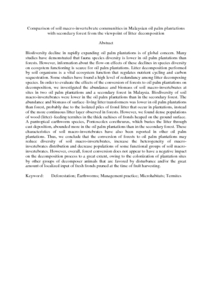Citation
Wonga, Mum-Keng and Tsukamoto, Jiro and Yusuyin, Yusufujiang and Tanaka, Sota and Iwasaki, Kozo and Tane, Ngai-Paing
(2016)
Comparison of soil macro-invertebrate communities in Malaysian oil palm plantations with secondary forest from the viewpoint of litter decomposition.
Forest Ecology and Management, 381.
pp. 63-73.
ISSN 0378-1127
Abstract
Biodiversity decline in rapidly expanding oil palm plantations is of global concern. Many studies have demonstrated that fauna species diversity is lower in oil palm plantations than forests. However, information about the flow-on effects of these declines in species diversity on ecosystem functioning is scarce for oil palm plantations. Litter decomposition performed by soil organisms is a vital ecosystem function that regulates nutrient cycling and carbon sequestration. Some studies have found a high level of redundancy among litter decomposing species. In order to evaluate the effects of the conversion of forests to oil palm plantations on decomposition, we investigated the abundance and biomass of soil macro-invertebrates at sites in two oil palm plantations and a secondary forest in Malaysia. Biodiversity of soil macro-invertebrates were lower in the oil palm plantations than in the secondary forest. The abundance and biomass of surface–living litter transformers was lower in oil palm plantations than forest, probably due to the isolated piles of frond litter that occur in plantations, instead of the more continuous litter layer observed in forests. However, we found dense populations of wood (litter)–feeding termites in the thick rachises of fronds heaped on the ground surface. A pantropical earthworm species, Pontoscolex corethrurus, which buries the litter through cast deposition, abounded more in the oil palm plantations than in the secondary forest. These characteristics of soil macro-invertebrates have also been reported in other oil palm plantations. Thus, we conclude that the conversion of forests to oil palm plantations may reduce diversity of soil macro-invertebrates, increase the heterogeneity of macro-invertebrates distribution and decrease populations of some functional groups of soil macro-invertebrates. However, overall, forest conversion does not appear to have a negative impact on the decomposition process to a great extent, owing to the colonization of plantation sites by other groups of decomposer animals that are favored by disturbance and/or the great amount of localized input of fresh fronds pruned at the time of fruit harvesting.
Download File
![[img]](http://psasir.upm.edu.my/55343/1.hassmallThumbnailVersion/Comparison%20of%20soil%20macro-invertebrate%20communities%20in%20Malaysian%20oil%20palm%20plantations%20.pdf)  Preview |
|
PDF (Abstract)
Comparison of soil macro-invertebrate communities in Malaysian oil palm plantations .pdf
Download (99kB)
| Preview
|
|
Additional Metadata
Actions (login required)
 |
View Item |

